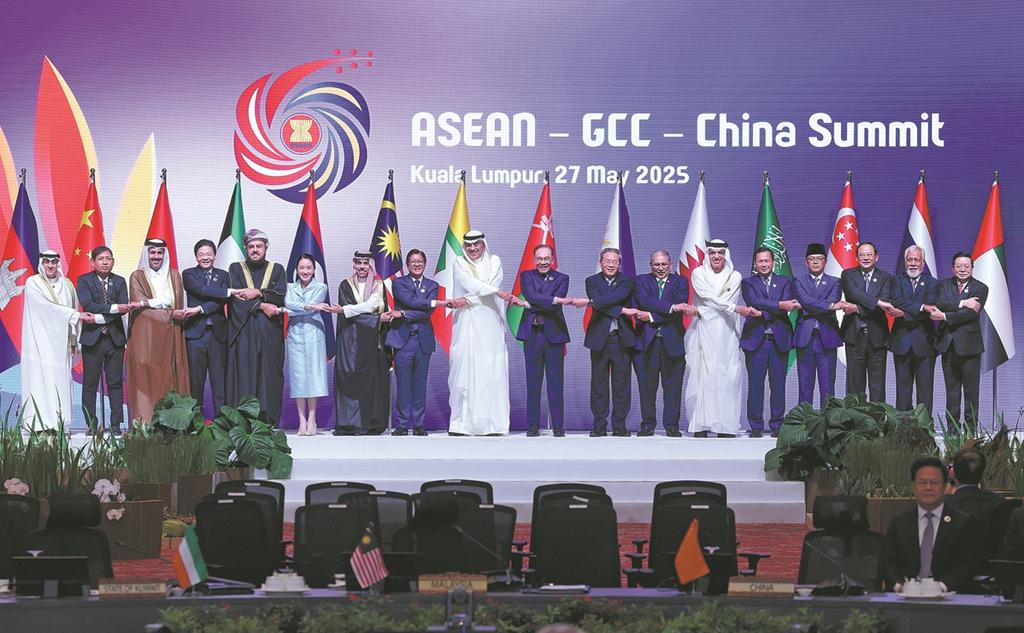Eric's Insight: What’s the effect of ASEAN-China-GCC summit?
The inaugural ASEAN-China-GCC Summit was held in Kuala Lumpur, Malaysia, on May 27. It resulted in a consensus on key issues such as the economy, energy, AI, and green growth, among others. Proposed by Malaysia, the summit is "a model of open regionalism." It aims to safeguard regional economic stability while promoting synergistic development across Asia.

Premier Li Qiang and foreign heads of state, heads of government and representatives of the Association of Southeast Asian Nations and the Gulf Cooperation Council attend the ASEAN-China-GCC Summit in Kuala Lumpur, Malaysia, on May 27. Photo/China Daily
As emerging Asian economies and prominent members of the Global South, both ASEAN and GCC states are vital partners in Belt and Road Initiative (BRI) cooperation. Geographically, China, ASEAN, and the GCC countries form a strategic triangle. This convergence is poised to have a far-reaching impact on regional prosperity.
Enhanced regional cooperation. The summit has established a unified framework integrating China, ASEAN (10 member states), and the Gulf Cooperation Council (6 Gulf nations). This framework forms a "Golden Triangle" encompassing 2.15 billion people and representing approximately one-quarter of the world’s GDP. However, trilateral trade only makes up 5 percent of global trade. This means much potential to be tapped.
Key trilateral commitments include aligning the BRI with ASEAN and GCC development strategies; deepening cooperation in energy, finance, and the digital economy; and advancing local currency settlements, among other initiatives. These efforts will strengthen defenses against external interference, thereby reinforcing peace and stability throughout Asia.
Deeper economic integration. ASEAN, China, and GCC each have their own advantages. ASEAN has a huge market and abundant labor resources. China has obvious advantages in technology and manufacturing, while the GCC has abundant energy and sovereign capital. Together, this trilateral synergy forms a self-reinforcing economic ecosystem of "resources-technology-capital-markets." This ecosystem acts as a catalyst for deeper economic integration across Asia.
The completion of negotiations on the China-ASEAN Free Trade Area (Version 3.0), along with accelerated progress on the China-GCC Free Trade Agreement, will significantly enhance the resilience of regional supply chains in Asia and strengthen energy security. These developments will promote regional openness and free trade, providing an effective countermeasure against unilateral tariffs.
Mutual learning & global governance. The ASEAN-China-GCC Summit marks a landmark moment in the rise of the Global South. It sends a clear message to the world: Global South nations are no longer passive recipients of the international order but active architects and reformers of global governance.
Amid a turbulent international landscape and slow global economic growth, the trilateral partnership between China, ASEAN, and the GCC addresses an urgent need. It challenges unilateralism and strives to make global governance more just and equitable.
China has decided to introduce an "ASEAN visa" for Southeast Asian countries, offering five-year multiple-entry visas to eligible applicants. During the summit, China also announced a visa-waiver pilot program for Saudi Arabia and three other nations, achieving full visa-free coverage for all GCC countries. These initiatives are expected to enhance people-to-people exchanges, cultural engagement, and mutual learning among civilizations, such as the Confucianism-Islam dialogue.
Written by Wang Shixue; Proofreading by Zu Hongbing and Wang Huan (YICC); English polishing by Franklin (CICG)